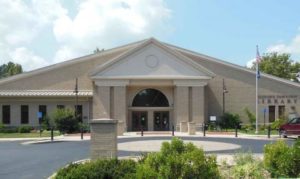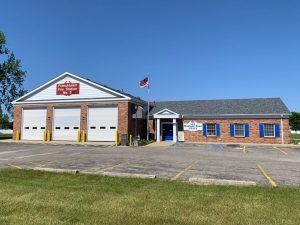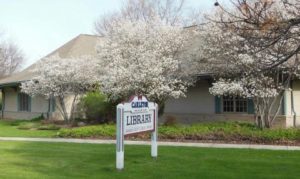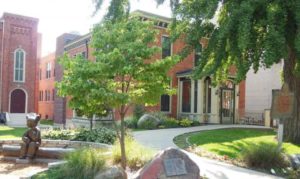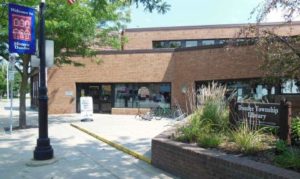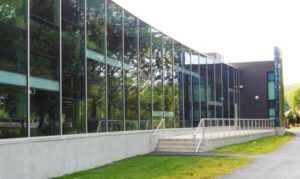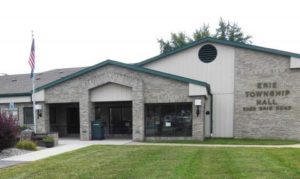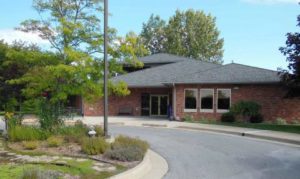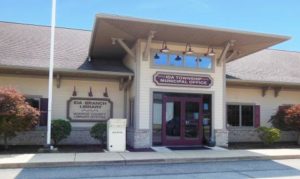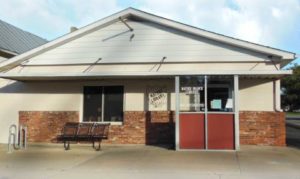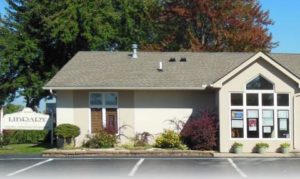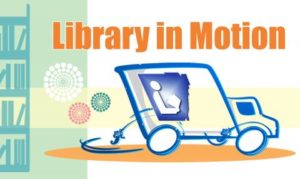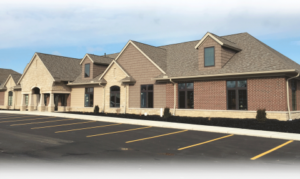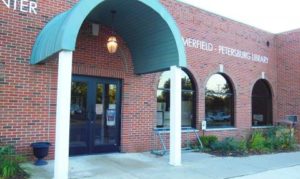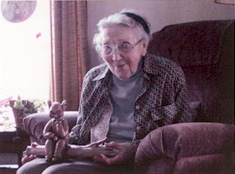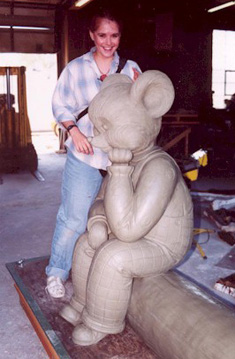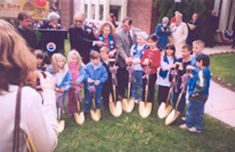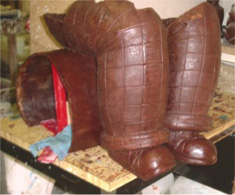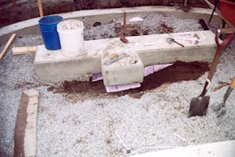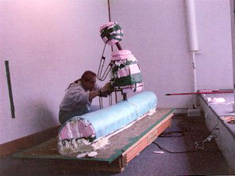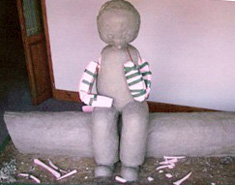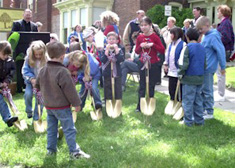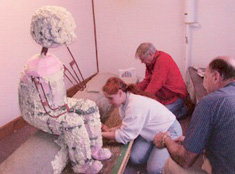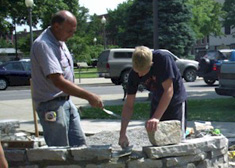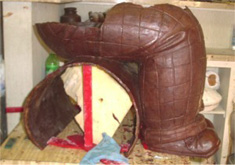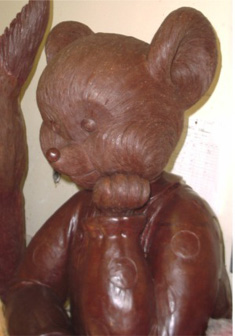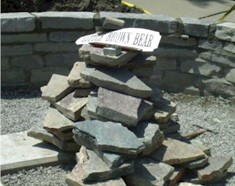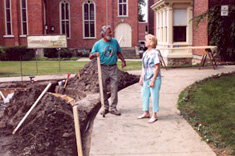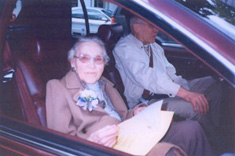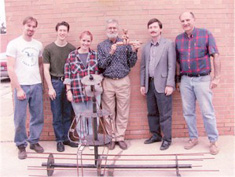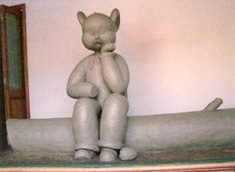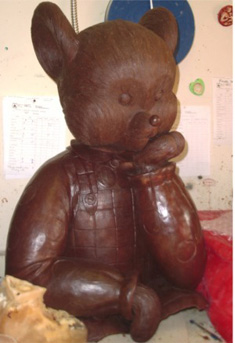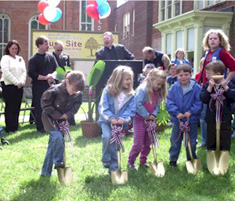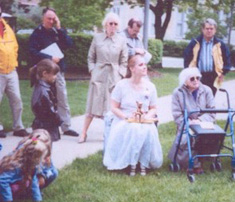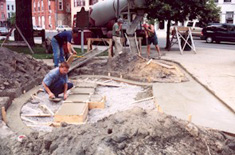
Amber Reed, Community Librarian
Dorsch Memorial Branch Library
18 East First StreetMonroe, MI 48161-2227
Phone: (734) 241-7878
Fax: (734) 241-7879
Sunday: Closed
Monday: 9:00 am – 7:00 pm
Tuesday: 9:00 am – 7:00 pm
Wednesday: 9:00 am – 5:00 pm
Thursday: 9:00 am – 7:00 pm
Friday: 9:00 am – 5:00 pm
Saturday: 10:00 am – 4:00 pm
Branch hours may be affected by holiday closings. Please see our Holiday Closing page for more information.
Dorsch Memorial Branch Timeline
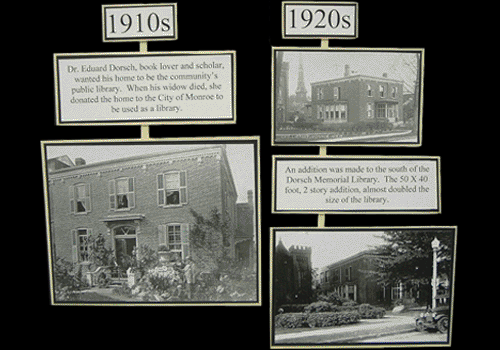
1910’s – Dr. Eduard Dorsch, book lover and scholar, wanted his home to be the community’s public library. When his widow died, she donated the home to the City of Monroe to be used as a library.
1920’s – An addition was made to the south of the Dorsch Memorial Library. The 50 x 40 foot, 2 story addition almost doubled the size of the library.
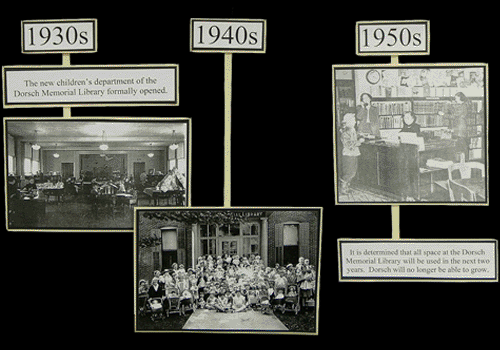
1930’s – The new children’s department of the Dorsch Memorial Library formally opened.
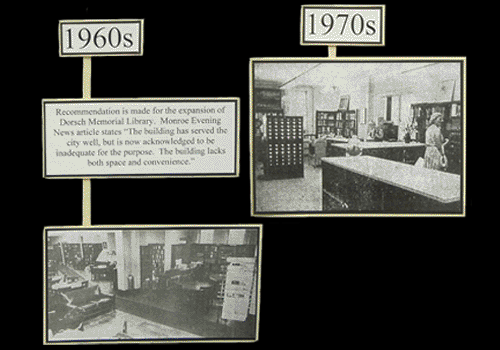
1960’s – The Dorsch Memorial Branch Library became part of the Monroe County Library System.
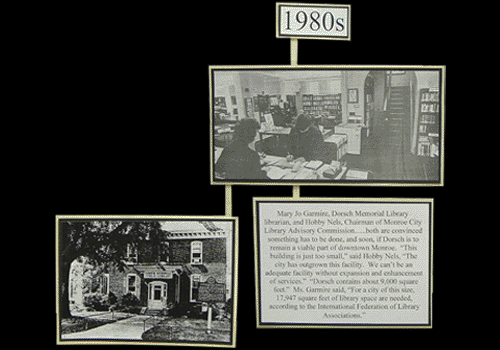
1980’s – The Dorsch Memorial Branch Library was remodeled to meet the Americans with Disabilities Act.

2000’s – Little Brown Bear statue honoring the books written by Elizabeth Upham McWebb was dedicated in front of the Dorsch Memorial Branch Library.
History of the Dorsch Memorial Branch Library
The first Monroe City Library was established in 1828. The library was under the supervision of the village council and presided over by the city clerk.
In 1837, the city was incorporated and the library was transferred and controlled by the common council and the school inspectors. Money raised by the council bought the books, which were brought to Monroe by wagons and steamers.
A small room in a building on the Public Square housed the books in 1842. The building contained the library and the office for the city clerk. The portion of the building that housed the library had formerly been the U.S. Land Office.
In 1866, a collection of German literature books were purchased for the German population. In 1873, the library was transferred to the Board of Education under an act of the legislature.
Over the next 15 years, the library would be housed in a number of buildings. The first move was to a brick building adjoining the First National Bank Building on Washington Street. The second floor rooms contained nearly 2,500 books. By 1900 the library had moved to 17 South Monroe Street. The library was open every afternoon and evening September through June. During the summer the hours were restricted to Wednesday evenings and Saturday afternoons.
In 1914 Augusta Uhl Dorsch died, and her home was left to the City of Monroe as a memorial to her husband Dr. Eduard Dorsch. By 1924, the public demand for library services spurred a 60 ft. addition to the building. The addition was built onto the south end, with the second floor providing an auditorium and a stage. Four years later the second floor auditorium was transformed into a children’s department where a regular story hour was conducted on Saturdays during the winter months. Children were not allowed in the main library downstairs, but came in a side door that led directly upstairs. The library now housed between 11,000 and 12,000 books.
The Dorsch Memorial Library continued operations throughout the Depression years. Records indicate that the general circulation for the library was 18,501 in 1936. Non-fiction constituted 34% of the circulation. The 1936 Annual Report noted that Monroe readers favored general literature, biographies and “useful arts”, which included engineering and mechanics. The following year an East Side Branch was established. In 1962 the Dorsch Memorial Library merged with the Monroe County Library, becoming part of the current Monroe County Library System. In 1986-87 the branch again underwent major renovations to make the building handicapped accessible. A new ramp and entrance, new restrooms, and an elevator were installed.
Programs are offered on a regular basis, including children’s storytimes and events in concert with the Downtown Monroe Business Network. Popular services include the availability of major newspapers, stock and mutual fund resources, and Internet access.
Cat’s Meow Village
Dorsch Memorial Library has been featured in the Cat’s Meow Historic Monroe series. A Ginkgo tree accessory piece is also available.
Dr. Eduard Dorsch and the Dorsch Memorial Library
Eduard Dorsch was born January 10, 1822 in Bavaria. He attended the University of Munich, studying medicine, botany, and philosophy. He left Germany after the 1848 revolutions, travelling to the United States with his wife, mother, and sister.
In Detroit he learned of the need for a German physician in Monroe, Michigan, and so he settled here. He and his wife Sophia had only one son, who died at eight months. Sophia died in 1884, and he married Augusta Uhl in November, 1885. Dorsch died two years later on his birthdate, January 10.
Dr. Dorsch was well-respected for his abilities as a physician, and for his research during the Civil War on the effects of rifle bullets in the human body. He wrote many volumes of manuscripts, largely unpublished, including poetry, plays, and satirical works. He painted watercolors of various botanical species, and was responsible for planting rare pink Egyptian and the yellow American lotus in Monroe marshes. He received a Ginkgo tree seedling from the Chinese ambassador to the United States in the mid-1860s, and planted it in his front yard. He kept many animals and birds, including several parrots which he kept in the house’s bay window. Politically, he campaigned for Lincoln, and there is evidence that his home was used as an Underground Railroad Station.
Dr. Dorsch willed his house, thought to be built in the 1850s, to the City of Monroe to be used as a public library. After his wife’s death in 1914, the house was given to the City, and opened in 1916 as a library. The northwest corner room on the first floor was to be a public “resting” room for ladies, and still contains some of the Dorsch’s furniture. Much of Dr. Dorsch’s personal library is still housed in the building, with the exception of his medical library which was donated to the University of Michigan. Some of his original artwork has been framed and is on display in the library.
Newspaper Articles about the Dorsch Memorial Branch Library
Monroe News Courier
Wednesday, Jan. 26, 1916
Dorsch Memorial Library
Sitting in their spacious home at 18 East First Street some twenty odd years ago two old people dreamed a dream. There in the still of a winter’s evening, as they read from their extensive library beside the roaring grate, they saw, away in the future, Monroe, Floral city of Michigan, with a new modern public library.
Although Dr. and Mrs. Eduard Dorsch, donors of the Dorsch Memorial Library, have both passed away there will soon be finished, according to plans left by Mrs. Dorsch, a memorial that will stand to them as a monument that would be a credit to kings – a building that is for the betterment of the public.
The idea of promoting a public library for Monroe dates back to the time when Dr. Dorsch lived. In his home that is soon to be converted into the new Dorsch Memorial Library, he had one of the rarest and most extensive libraries in the state of its kind. Most of the books were in German.
Old German authors whose pens had stirred the minds and hearts of Germany long before America was born were found there in book form. Teutonic writers of every kind of literature had contributed to the library of Dr. Dorsch until his collection became very extensive. Adding to this the books of the present authors, he had a very complete selection of volumes.
At the death of Dr. Dorsch, about twenty years ago, the books were willed by him to the then struggling library of Monroe. In fact it could hardly be called a library. But they were set aside and designated as the “Dorsch Memorial Library of Books.” Many of the books were of a very deep nature as would become a man of the character of the donor.
After that time his widow, Mrs. Augusta Dorsch, continued to live in the old home on First street. She lived about 18 years longer than her life mate, but during her life never lost sight of the vision that she and her husband had of that improvement to the city that they loved. Most older people live in the past, dwelling on the things that have gone, but she had something to look forward to in the future. And when she passed to her final resting place and her will was opened by the administrators of the estate, Carl Kiburtz and Jesse Root, it was found that the old Dorsch home had been willed “to the city of Monroe” for a library.
Soon after the city, which really had nothing to do about carrying on the work so nicely started by this thoughtful old lady, turned over the proposition of remodeling the home and making it into a up-to-date library that would be a credit to the city of Monroe, to the School Board of the city of Monroe. They took it in hand, plans were made, and work started on the home.
This was about a year ago. Within a few weeks the Dorsch Memorial Library will be finished. The painter will have given the place the last caress of the brush, the workman the last tap of the hammer, and the stamp of “Finished” will be in evidence all over it. The old colonial house will have been converted into a modern library and the dream of the two old people, as they sat in the same house, that evening some twenty odd years ago, will have been realized. Monroe will have her first library building.
Only a visit to the place can give some idea of the beauty of the place. Many pass by the brick house, with its white shutters and admire the pleasing effect that the ivory paint has had on it, but few know the surprise that awaits them on the inside.
Upon approaching the Dorsch Memorial Library the first attractive thing is the name, in gold letters, that have been placed over the door. A new entrance next greets the eye with French plate leaded glass converting the little vestibule into a very light entrance. Colonial is the whole design from the outside and the same scheme is carried out on the interior.
What more appropriate style of architecture could be used with the large rock, in the front yard marking as it does the place where some general had his headquarters during the battle of River Raisin? On the other side of the walk is a large mound of boulders hiding a well. Inscribed on one of these rocks will be found a motto placed there in Latin by the old doctor which is translated, “Water is Best”.
Entering the vestibule a veritable wonderland greets the eye.
From the pure white of the wood work, carrying out the colonial effect on the interior, to the deep tiffany buff of the wall the whole place has received the attention of expert decorators. Entering from the main entrance a large room is the next thing in which one finds himself. Cork linoleum makes walking noiseless and indirect light casts a soft glow over the whole place. It is a room beautiful. Nothing in the art of the decorator has been spared and from the appropriate border that adds a finishing touch to the walls to the dull brass of the fixtures, the rooms are one of harmonious blending of colors.
A large bay window about ten feet long and fully two feet deep is on the east side of the room. It was here that Mrs. Dorsch had her bird cage and the bay window was built; full of windows, for that purpose. Between the entrance of this beautiful window-room the librarian’s desk will be placed, and will face west. The room will be filled with tables, chairs and all comforts that would tempt the lover of an evening with books. Because of some delay in shipping, the shelves for the books are not yet placed, but they should arrive this week. Shelves will be placed around the walls and horseshoe shaped standing shelves will be placed in the room.
South from the room, and directly ahead of the entrance as one walks into the building is the librarian’s work room. It is finished the same as the reading room and will be a little retreat for the librarian when she has work of checking over books and taking care of the library work On the west side of the building, directly across from the librarian’s desk is another room, off of the large room. This will be another book room, and here will be found all of the leading magazines, where the latest in the magazine world can be sought. Appropriate furniture has been purchased for this magazine room.
At the right of the entrance is the ladies’ rest room and toilet. It is finished in soft green, with white woodwork. it is one of the artistic rooms of the library.
In all of the rooms steam heat will keep the temperature at the right pitch. The radiators as placed by the Monroe Heating & Lighting Company are fines ones, with just the right shapes and sizes for the rooms in which they are to be used.
Between the two rooms designated as the ladies’ rest room and the magazine room, is an arched stairway that leads to the second story of the library. Colonial in design the stairs wind their way to the second floor where two rooms are for library purposes. The rest are to be used for the apartments of Mr. and Mrs. Robt. Hurschman who will keep the building in first-class condition, attend to the wants of the librarian. They will have two smaller down stairs rooms in the rear.
The woodwork on the second floor is natural finish, a golden oak. Directly at the head of the stairs is another book room. Lined with shelves, it will be the home of old records, legal books, reference books, etc. It will be a welcome retreat for those who want to delve into the depths of some knotty problem.
A room has been fitted so that the school board will have a place to hold their meetings. The finish of this room is in buff and it will be fitted with modern office furniture.
The new home of the Monroe library will be finished and ready for dedication about the middle of February if the plans of those who have had the project in charge are not changed. If the shelves arrive the building will be complete for the painters and decorators expect to leave the building the latter part of this week.
About $2,500 have been expended by the School Board in fitting up the place. Too much credit cannot be given them for their work in giving to this city such a building. It was no small task that was before them to get skilled workmen to tear out the partitions and get the building in the shape that it is. But that their work has been thorough and that they have given Monroe a beautiful library will be proven when it is opened to the public on the day of dedication.
R-Comm.
March 2, 1916
Old Home of Pioneer Physician and Poet Opened as New Library Next Week
The Dorsch Memorial Library bequeathed to the city by the will of the late Mrs. Edward Dorsch, an early German settler, will be formally opened to the public some evening next week. The members of the Board of Education and their wives, in company with Mrs. Jennie T. Wallace, librarian, will receive visitors and a brief program is being prepared for the occasion.
The moving of the old library, consisting of more than 8,700 volumes, began about a fortnight ago and for the past ten days Mrs. Wallace, with four or five assistants, has been at work arranging the books in the new quarters. The use of book stacks will render the capacity of the new library far in excess of the old.
Extensive remodeling under way since last October, costing about $4,000 has transformed the building into a magnificent one for its peculiar use and Monroe now has a library of which every citizen may well be proud. It was done under the management of the School Board.
The sum expended includes the cost of new furniture, mahogany desks, filing bureaus, tables, chairs, and book shelves, all especially designed for library work, also the installation of a steam heating plant; electric lights throughout with the inverted domes from the ceilings in all the main rooms and other modern conveniences. Partitions removed leave on the lower floor, a spacious room to the left of the entrance, with fireplace and large baywindow. Here is stationed the librarian’s desk. A special place for children to read is at the front windows and the baywindow is reserved for magazines, that is the recent periodicals. On the right of the entrance is a comfortable rest room with lavatory opening off, and back of this the reference room, which like the others is fitted with the latest mahogany. A peculiar little enclosure, octagonal in shape, still farther to the rear, will serve as the librarian’s work-room. Decorations are in excellent taste, the wood-working being in glistening white enamel with mahogany doors. The walls are tinted in a tan shade with contrasting stencil border.
On the second floor the main room is for government documents and volumes on that order. The Friends in Council, the oldest literary society in the city, has been invited to hold their weekly meetings here. Just off of this room is a finely fitted office for the Board of Education, with a desk for the Visiting Nurse, who will have certain hours every day there in order to be easily reached by patients. Living rooms for the janitor are on each floor at the rear of the building.
The entrance to the library is in handsome glass work, with “Dorsch Memorial Library” in guilt letters.
The property as it was left to the city without these renovations last April, was estimated at between six and seven thousand and is the largest windfall of the kind ever alighting here.
This old home from which the new library is evolved, has always been occupied by the family who built it; occupants who have left a distinct memory here for they belonged to the period before individualism in the little town had been swallowed up or rather leveled by the growing city.
The eight room, two story brick house located on First Street between Washington and Monroe, was built in 1850 by Dr. Edward Dorsch. The doctor, a stalwart, German figure with long flaxen locks and beard, was a graduate of the University of Vienna and stood out in fine relief for many a year as the scholar of this quaint village “Under the Elms.” A native of the city of Munich, he was a member of a small circle of highly educated Germans who for political reasons were exiles from home and had made a new abiding place for themselves a this end of Lake Erie, which was then a popular terminus of immigration. And not only a successful general practitioner, the Doctor was a man of letters, a naturalist, and a verse writer of such ability as to go down as one of the greatest German-American poets.
Mrs. Dorsch, the donor of this gift to the city, was Miss August Uhl from the village of Volmarstein in the Provinz of Westphalia, Germany. Her father was a man of affluence and wealth, but lost a considerable portion of his fortune upon coming to America, and the daughter settling in Monroe, opened a little shop in one of the primitive wooden buildings which then formed the main business section of Monroe. Here were exhibited imported novelties, real laces and embroideries such as had never before been purchasable in the locality. The shop thus became a rendezvous for a lucrative class of shoppers, while the little saleswoman, soon recognized as a person of superior taste, was admitted into the fellowship of her countrymen whose society was of the most desirable order and eagerly sought by all those qualified to take part in it. She possessed unusual business sagacity and soon moved into finer quarters and laid up quite a fortune for herself.
Later she was married to Dr. Dorsch, the pair passing the remainder of their days in the home which is now converted into the new library. The couple were united by exceptional bonds of affection, their story being perhaps seldom paralleled outside of the extraordinary writings of such authors as Goethe and Schiller. As a proof of the above the two lie buried in the same grave at Woodlawn according to a request made in the Doctor’s will.
Dr. and Mrs. Dorsch filled their home with valuable books, with specimens dear to the heart of the naturalist, with curios from abroad and kept a number of gorgeous birds from tropical countries in their conservatory which lent an interesting foreign air to the place.
The couple were patriotic to a great degree, preserving German ways and German thought as much as was possible in a strange land, often charming visitors with vivid descriptions of the Fatherland. Mrs. Dorsch had made several trips to Germany since coming to America. They were also planning to tour Europe and visit Egypt when his death cut short the arrangements. She occupied the house for many years after his death, her sole companions often being the coo-coo clock and “Polly,” the South American parrot who lived to be nearly sixty years old and whose hoarse croak was a familiar sound about the central part of the city long before the town was known to the present inhabitants. The will which bestowed the house to the city gave the bird to the zoological gardens at Toledo, where he still lives among feathered folk of his own kind.
During her latter occupancy of the new library, Mrs. Dorsch still remained the exemplary German housekeeper, guarding her possessions with careful eye. Her chief solace lay in her books, her flower garden, her religion and her youthful memories and under these refreshing influences she maintained a heart like one in its prime even up to her last, which was her 78 th year. The will states that the old portraits of the Doctor and herself are to remain on the wall of the living room, where they were hung long ago.
K.N.N.
Monroe News Courier
March 7, 1916
Dorsch Memorial Library Opened to Public Last Night
The beautiful new Dorsch Memorial Library was formally opened to the public last evening, with services fitting to commemorate the appreciation of the valuable gift.
There were about seventy-five people who gathered to enjoy the evening’s program.
Aubrey Choate played a very beautiful piano solo and “Impromptu” and Miss Kline sang, “O Heart of Mine”. Miss Charlotte Dunbar sang a very pretty lullaby and Miss Doris Eber rendered “Venetian Song” on the piano.
The invocation was spoken by Rev. C. O’Mera.
Boyez Dansard gave the opening address and made mention of the fact that the large central room, about which the books are arranged, was also the library used by Dr. Dorsch forty-eight years ago.
Mr. Dansard gave a short sketch of the life of Dr. Dorsch from his boyhood until his older years, when he chose Monroe as his abode and built the Dorsch home which is now the library. He was a graduate of the University of Munich, and perfected his studies at Vienna. He had some trouble with his government and decided to come to America, because he believed that here he could think, talk, write, and act according to the dictates of his own conscience. He was a man who had many friends, but few intimate acquaintances.
Mr. Dorsch often expressed the wish that the home should some day become a library. After his death, Mrs. Dorsch pondered over whether it should be an Old Folk’s Home, a Masonic Home or a hospital. She finally decided to carry out the wishes of her husband and willed it to the city for a library, with practically the only restriction being, that the room on the right, as one entered be kept for a ladies rest room, as it now is.
Mr. Dansard commended the committee, which consisted of Dr. C.T. Southworth, chairman and William P. Cooke for the way in which they had carried out the improvements on the Library. Mr. Dansard in closing said, “The library is one to be proud of, it is centrally located and is a great credit to the city.”
Dr. Southworth who is chairman of the committee and who has had almost entire charge of the remodeling of the library was to have spoken but was not able to be present.
Dr. W.C. Burns gave a few fitting remarks, relative to the usefulness and influence of books, “A book is a living thing,” said Dr. Burns. “Books cheer our life, more than any other thing; – they are our best companions.”
Supt. E.E. Gallup spoke for a few minutes. Among other things he said: “A library is the place where we may commune with saints, saviors, philosophers and master minds of the past and present.”
“However, we will make a mistake if we expect to find in the average library all the books to fit our needs. Some of us are taking special studies and we should not be annoyed if just the special book we require is not there. For special things we sometimes have to look to other sources for the books. A library fills the needs of the people, in general, and the library with a limited amount of funds cannot meet special needs but it will serve the best interests of all. However, in some cases a wish for certain books, if expressed to the librarian, may often be the means of bringing that book to your service.”
In closing Supt. Gallup said, “We should be vastly proud of the gift made to us and should make the very best use of it.”
At the conclusion of the program, the Monroe Club orchestra furnished music the remainder of the evening.
Those who braved the inclement weather to attend the formal opening of the library were more than repaid in the interesting and enjoyable program which had been arranged.
It really seemed as one sat in the long room lined with shelves filled with books and listened to the words which dedicated the library to the book loving public and made it an integrated part of this city, that those two, who by their thoughtfulness, had made it possible for Monroe to have this wonderful gift, must somehow know the great appreciation which is felt for the bestowal.
The library will be open all afternoons from two until five o’clock and in the evenings from seven until eight o’clock and Saturday evenings until eight-thirty.
Monroe News Courier
April 5, 1916
New Fiction Section Opened
A popular fiction section with all of the latest books has been opened in the Dorsch Memorial Library. Because of the demand for popular fiction this will be operated on a new plan. Each book will cost the reader 5 cents for a book with he will be allowed to keep one week. At the end of this time, if he has not finished the book he can rent it over again. This will be called the rental section. This section was opened this week. All of the chairs and tables arrived the early part of this week. With the new equipment the library has assumed a new look and the interior is very pretty.
Dorsch Room Commemorative Plaque
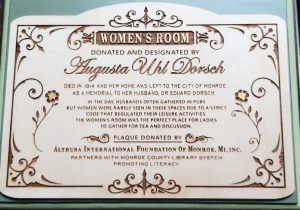 On March 18, 20205, the Dorsch Memorial Branch Library was deeply honored to receive a beautiful, hand-crafted plaque from Altrusa International of Monroe, MI. This plaque, soon to be displayed in the Dorsch Room, commemorates the request made by Dr. Dorsch’s wife, Augusta, to dedicate the space as a sitting and visitation area for the Women of Monroe. Receiving this recognition during National Women’s History Month was an incredible honor.
On March 18, 20205, the Dorsch Memorial Branch Library was deeply honored to receive a beautiful, hand-crafted plaque from Altrusa International of Monroe, MI. This plaque, soon to be displayed in the Dorsch Room, commemorates the request made by Dr. Dorsch’s wife, Augusta, to dedicate the space as a sitting and visitation area for the Women of Monroe. Receiving this recognition during National Women’s History Month was an incredible honor.
Artist credit to: Jenni Bert / Tiger Quill Images.
Book Clubs
Technology Available
-
Fax Machine
-
Free Wireless Internet
-
Photocopy machine – B&W 10 cents, color copies are 50 cents
-
Public Computers
Community Information
Pictures of the Little Brown Bear Statue
Dorsch Memorial Branch Events
![]()
